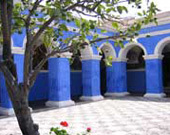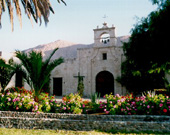Arequipa the White city, call for its white volcanic stones, has many contructions made of this material from the Colonial time. Arequipa is also the ideal please for aclimatization. Perfect to enjoy your time while knowing the local culture.
DURACION: 3HRS
The departures for this tour is available in the morning or afternoon. We pick you up at your hotel to start the tour.
In the city tour we visit the follow places: -Main Square, city of Arequipa
Bordered by various arched walkways and the Cathedral, the Main Square possesses a beautiful bronze fountain of three plates crowned by the figure of a sixteenth century soldier. Of this person, who is called “Tuturutu”, the story says he was in charge of warning of any new event. Around the square, you see three granite portals with brick and lime bases: Portal del Cabildo (Portal de la Municipalidad), Portal de las Delicias (Portal de San Agustín), and Portal del Regocijo (Portal de Flores).
-Cathedral, city of Arequipa
It is considered one of the first seventeenth century religious monuments of the city. It is built of sillar (white volcanic stone) with a brick base. Destroyed by fire in 1844, it was rebuilt in 1868 by the Arequipa architect Lucas Poblete. He used a Neoclassical style and placed the entrances of church on the flanking naves. In 2001, the building was struck hard by an earthquake, which seriously damaged its towers.
-Iglesia de La Compañía and complex (The Church of the Company of Jesus Christ)
This complex, made up of buildings constructed by the Jesuits for religious and living purposes, is a representative monument of the seventeenth century religious architecture (1660). The church itself rises from the center of the buildings. It was designed in 1573 by Gaspar Baez and destroyed by an earthquake in 1584. The current structure dates from 1650. Inside you find sixty-six canvases from the Cusco School from such artists as Bernardo Bitti and Diego de la Puente.
-Monasterio de Santa Catalina (Saint Kathleen Monastery)
Constructed to shelter the daughters of the wealthiest families of the city with a religious vocation, the monastery was inaugurated on October 2, 1580, under the name of Santa Catalina of Siena to be a totaly cloistered religious center, and it remained that way until August 15, 1970.
It occupies an approximate area of 20.000 m2 (215.285 feet2), and its placement is similar to the first neighborhoods of Arequipa. The building exhibits rooms of very different architectural design. One of the areas has been established as a gallery to display the canvasses of the Cusco, Quito, and Arequipa Schools. There are other rooms, or sectors, to visit as well, like el Claustro de la Portería (the Gate Cloister), el Museo Precolombino (the pre-Colombian Museum), el Claustro de San Francisco (the Cloister of Saint Francis), etc.
-Yanahuara Lookout
Located 2 km from downtown Arequipa is the Yanahuara distric who was built in the nineteenth century and is composed of a series of sillar stone arches where the words of famous Arequipa citizens have been engraved. This spot is a wonderful view point of the city and Mount Misti volcano.
Includes:
- Guide
- Entrance fee
- Transportation.
|



